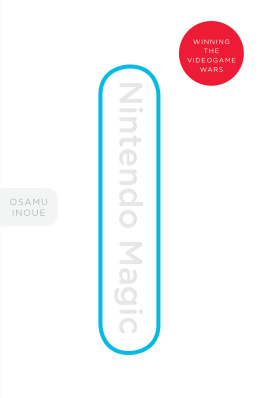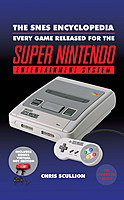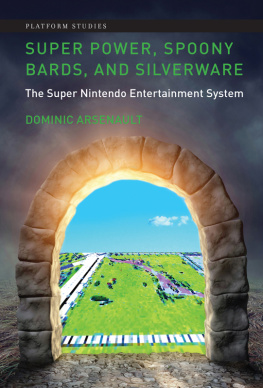Title Page
101 Amazing Facts about the SNES
...also known as the Super Famicom
Jimmy Russell
First published in 2017 by
AG Books
www.agbooks.co.uk
Digital edition converted and distributed by
Andrews UK Limited
www.andrewsuk.com
Copyright 2017 Jimmy Russell
The right of Jimmy Russell to be identified as the author of this work has been asserted in accordance with the Copyright, Designs and Patents Act 1998.
All rights reserved. No part of this publication may be reproduced, stored in a retrieval system, or transmitted, in any form or by any means without the prior written permission of the publisher, nor be otherwise circulated in any form of binding or cover other than that in which it is published and without a similar condition being imposed on the subsequent purchaser. Any person who does so may be liable to criminal prosecution and civil claims for damages.
The views and opinions expressed herein belong to the author and do not necessarily reflect those of AG Books or Andrews UK Limited.
All facts contained within this book have been researched from reputable sources. If any information is found to be false, please contact the publishers, who will be happy to make corrections for future editions.
Introduction
This entry in Jimmy Russells Games Console History series is all about Nintendos iconic SNES - the Super Nintendo Entertainment System, also known as the Super Famicom in Japan. The book contains over 100 facts about the console, organised into sections such as hardware, peripherals, history, legacy and more, including some incredible information you probably never knew. From retro gamers who were there at the time to total n00bz who think a PlayStation is Old Skool, theres something in this fascinating book for everyone!
The Game Show
This book is brought to you by The Game Show .
The Game Show is one of the UKs foremost retro gaming YouTube channels. Focusing on Great British gaming, The Game Show consists of two British blokes who enjoy creating positive video games content, nostalgia and easy-going videos covering everything from the ZX Spectrum to the latest high-end gaming PCs. If youre into gaming old or new, subscribe to The Game Show.
http://www.youtube.com/thegameshowuk

History Part One
- The SNES is Nintendos follow up to the hugely successful NES.
- In Nintendos homeland, Japan, the machine was known as the Super Famicom.
- Famicom stands for Family Computer - pretty obvious when you think about it!
- Like the Famicom before it, the Super Famicom was designed by Masayuki Uemura.
- The Nintendo Super Famicom was launched on November 21 st 1990 in Japan.
- Nintendo were late to the 16-bit market; NEC had launched the PC Engine in 1987, and Segas Mega Drive had been released in 1988.
- Despite the late arrival, the Super Famicom quickly became a success, selling 300,000 units on the first day of sale.
- The Japanese launch was so successful that the streets were completely packed with people trying to get hold of the new Nintendo console. In response, the Japanese government requested that all future console launches be held at the weekend, to avoid disturbance to working citizens!
- Now the crown kings of the Japanese console market, Nintendo launched the redesigned and renamed Super Nintendo Entertainment system in North America on August 23 rd , 1991.
- The UK release date was almost nine months later - in April 1992.
Peripherals
- The standard controller had changed significantly from the NES; four face buttons, two shoulder buttons and a much more ergonomic, rounded shape.
- Nintendos follow up to the NES Zapper was the SNES Super Scope - a huge lightgun bazooka, the Scope was a wireless device bundled with exclusive light gun software.
- Aside from the bundled Super Scope Six game, the Super Scope is compatible with some 12 SNES games, including hidden or optional compatibility, such as the ability to blow up the eponymous characters in Lemmings 2.
- BatterUP was a two foot long foam-covered baseball bat manufactured by Sport Sciences Inc. It was compatible with around ten different baseball games on the SNES.
- Following on from the NES Advantage , the SNES Advantage was an arcade-style joystick with turbo settings.
- Mario Paint came bundled with the SNES Mouse in 1992. Incredibly, the SNES mouse is compatible with a whopping 35 games, including all the Super Scope games.
- The Super Multitap allowed up to five players to play together. In Japan, the Multitap was shaped like Bombermans head!
- The Super Game Boy allowed gamers to play their Game Boy games on the big screen, enhancing the graphics and adding custom borders around the screen.
- In Japan, the Super Famicom got the Satellaview . A revolutionary product for the 1990s, the Satellaview allowed gamers to download exclusive new games via a satellite radio station.
- Additional third-party peripherals included the Life Fitness Entertainment System (basically an exercise bike) and the TeeV Golf Club, The Only Video Golf Game With Swing !
Hardware: Part One
- The SNES was a 16-bit console, using a Ricoh 5A22 CPU, clocked at 3.58MHz.
- The hardware supported 32,768 colours and ADPCM stereo audio.
- The consoles AV multi-out port supported composite video, S-Video and RGB SCART.
- The base unit used seven hardware modes to render output to the screen, with Mode 7 famously able to translate and transform 2D imagery to simulate 3D effects.
- There were five different version of the SNES / Super Famicom released; the Japanese SHVC-001, the American SNS-001, the PAL SNSP-001A, the America SNS-101 and the Japanese SHVC-101.
- The 101 models were known as the SNES Mini, or the SNES Jr in the USA and Japan respectively.
- Unfortunately due to the hardware redesign, the 101 models are not compatible with the Satellaview add-on and only export composite video.
- The game cartridges used in the console were referred to as Game Paks in most western regions, and Cassettes in Japan and Latin America.
- The smallest cartridge games were 2Mbit, but the cartridges were known to support up to a pretty hefty 48Mbit.
- Cartridges would regularly contain a battery back-up for game saves, extra RAM and sometimes additional co-processors (more on that later!)
Top Selling Games
According to our best verifiable sources, in reverse order here are the best-selling SNES games of all time...
- Donkey Kong Country 3: Dixie Kongs Double Trouble! (3.5 million units)
- Street Fighter II Turbo: Hyper Fighting (4.1 million)
- Super Mario World 2: Yoshis Island (4.12 million)
- The Legend of Zelda: A Link to the Past (4.6 million)
- Donkey Kong Country 2: Diddys Kong Quest (5.2 million)
- Street Fighter II: The World Warrior (6.3 million)
- Super Mario Kart (8.7 million)
- Donkey Kong Country (9.3 million)
- Super Mario All-Stars (10.6 million)
- Super Mario World (20.6 million)
Impact
- The era that the SNES launched in would quickly see one of the most hotly-contested rivalries of all time, fought between Nintendo and Sega. This era is generally known as the Console Wars.
- Despite Sega getting a head start, having more games and being cheaper, Nintendo somehow stormed the console market. Admittedly, both companies played every dirty trick in the book in an attempt to outdo one another.
- Over its lifetime, the SNES/Super Famicom sold 49.1 million units.
- Just over 23 million of these were sold in the Americas, ultimately beating Sega in the North American market.
Next page






